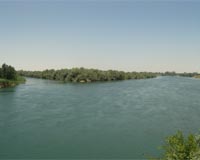| . |  |
. |
Paris (AFP) Sept 20, 2009 Two-thirds of the world's major deltas, home to nearly half a billion people, are caught in the scissors of sinking land and rising seas, according to a study published Sunday. The new findings, based on satellite images, show that 85 percent of the 33 largest delta regions experienced severe flooding over the past decade, affecting 260,000 square kilometres (100,000 square miles). Delta land vulnerable to serious flooding could expand by 50 percent this century if ocean levels increase as expected under moderate climate change scenarios, the study projects. Worst hit will be Asia, but heavily populated and farmed deltas on every continent except Australia and Antarctica are in peril, it says. On a five-tier scale, three of the eleven deltas in the highest-risk category are in China: the Yellow River delta in the north, the Yangtze River delta near Shanghai, and the Pearl River Delta next to Guangzhou. The Nile in Egypt, the Chao Phraya in Thailand and the Rhone River delta in France are also in the top tier of danger. Just below these in vulnerability are seven other highly-populated deltas, including the Ganges in Bangladesh, the Irrawaddy in Myanmar (Burma), the Mekong in Vietnam and the Mississippi in the United States. These flood plains and others all face a double-barrelled threat, reports the study, published in the journal Nature Geoscience. On the one side, a range of human activity -- especially over the last half-century -- has caused many delta regions to subside. Without human interference, deltas naturally accumulate sediment as rivers swell and spread over vast areas of land. But upstream damming and river diversions have held back the layers that would normally build up. Intensive subsurface mining has also contributed mightily to the problem, notes the study, led by James Syvitski of the Institute of Arctic and Alpine Research at the University of Colorado. The Chao Phraya delta, for example, has sunk 50 to 150 millimetres (two to six inches) per year as a result of groundwater withdrawal, while a 3.7-metre (12-foot) subsidence of the Po Delta in Italy during the 20th century was due to methane mining. Indeed, oil and gas mining contribute to so-called "accelerated compaction" in many of the most vulnerable deltas, according to the study, the first to analyse a decade's worth of global daily satellite images. The other major threat is rising sea levels driven by global warming. In a landmark report in 2007, the UN's Intergovernmental Panel on Climate Change (IPCC) predicted oceans would rise by 18-59 centimetres (7.2 and 23.6 inches) by 2100. More recent studies that take into account the impact of melting icesheets in Greenland and Antarctica have revised that estimate upwards to at least a metre (39 inches) by century's end. The already devastating impact of such increases will be amplified by more intense storms and hurricanes, along with the loss of natural barriers such as mangroves. In the Irrawaddy delta the coastal surge caused by Cyclone Nargis last year flooded an area up to six metres (20 feet) above sea level, leaving 138,000 people dead or missing. "All trends point to ever-increasing areas of deltas sinking below mean sea level," the researchers concluded. "It remains alarming how often deltas flood, whether from land or from sea, and the trends seems to be worsening." Share This Article With Planet Earth
Related Links Water News - Science, Technology and Politics
 Turkey agrees to up Euphrates flow to Iraq: Baghdad
Turkey agrees to up Euphrates flow to Iraq: BaghdadBaghdad (AFP) Sept 19, 2009 Turkey has agreed to up the flow of water along the Euphrates river to Iraq for a month, Baghdad said Saturday, amid tensions between the two sides over distribution of the precious commodity. The agreement came after talks in Istanbul involving Iraqi Foreign Minister Hoshyar Zebari and Turkish Environment Minister Veysel Eroglu, following a months-long war of words between Baghdad and ... read more |
|
| The content herein, unless otherwise known to be public domain, are Copyright 1995-2009 - SpaceDaily. AFP and UPI Wire Stories are copyright Agence France-Presse and United Press International. ESA Portal Reports are copyright European Space Agency. All NASA sourced material is public domain. Additional copyrights may apply in whole or part to other bona fide parties. Advertising does not imply endorsement,agreement or approval of any opinions, statements or information provided by SpaceDaily on any Web page published or hosted by SpaceDaily. Privacy Statement |